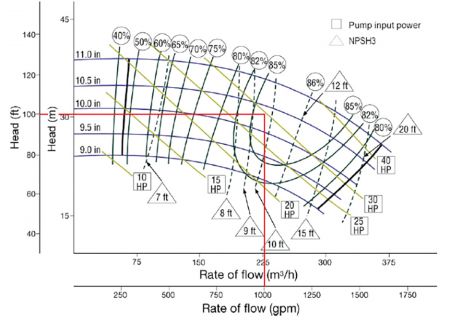
How do I determine the power required when looking at a typical manufacturer’s curve?
A typical pump curve (Image 1) includes the pump head for various impeller trims as a function flow rate. It also includes lines of constant efficiency, power and NPSH3. There are two ways to estimate the power for a specific operating point.

For the flow and head, you can see where it lines up between the lines of constant power to get an estimate. In Image 1, the design flow or 1,000 gpm and 100 feet of head will require approximately 30 horsepower (hp). From this curve, we can also see that if a higher flow rate would be needed for the appropriate pump trim, it would exceed the 30-hp line, and the next size motor would be required for full curve coverage.
For any flow and head, you can find the closest efficiency and manually calculate the power required.
For the same design point in Image 1, we can see that the efficiency will be between 82% and 85% but closer to 85%, so let’s pick 84%. For water at ambient temperature (specific gravity = 1.0), the power can be calculated using Equation 1.

If the specific gravity of the liquid is different than water, it can be added to the numerator to adjust the required power up or down.
For more information on pump curves and power consumption, refer to Hydraulic Institute training resources at www.pumps.org/training.
Read more HI Pump FAQs by clicking here.

